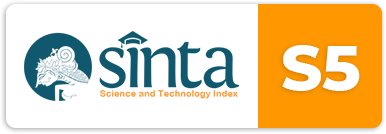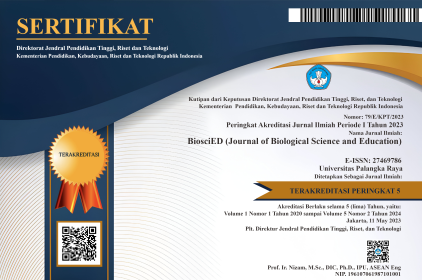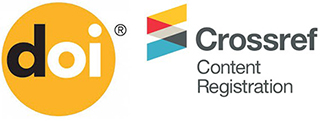Efektivitas Ekstrak Buah Pir Dalam Menghambat Streptococcus Pyogenes Pada Media NA
Effectiveness of Pear Fruit Extract in Inhibiting Streptococcus Pyogenes in NA Media
DOI:
https://doi.org/10.37304/bed.v6i1.22192Keywords:
Streptococcus pyogenes, Buah pir, Antibakteri, Difusi cakramAbstract
This study aims to determine the effectiveness of pear fruit extract (Pyrus pyrifolia) in inhibiting the growth of Streptococcus pyogenes in vitro using the disk diffusion method on Nutrient Agar (NA) media. Infection by Streptococcus pyogenes is the main cause of acute pharyngitis and often shows resistance to certain antibiotics, so natural treatment alternatives are needed. Pear fruit extract was tested at concentrations of 25%, 50%, 75%, and 100%. The test was conducted using the disk diffusion method on Nutrient Agar (NA) media, with inhibition zone measurements taken after incubation for 48 hours at 37°C. The results showed that all concentrations of the extract were able to form inhibition zones, with the 100% concentration producing the largest inhibition zone. Analysis showed a correlation between increasing extract concentration and antibacterial effectiveness, although it was not completely linear. The content of phytochemical compounds such as flavonoids and phenols in pears is thought to play a role in disrupting bacterial cell membranes and cell metabolism. This study supports the potential of pears as a natural antibacterial agent against Streptococcus pyogenes and contributes to the development of natural-based therapies to overcome antibiotic resistance.
Downloads
References
Alexandre, E. M. C., Coelho, M. C., Ozcan, K., Pinto, C. A., Teixeira, J. A., Saraiva, J. A., & Pintado, M. (2021). Emergent technologies for the extraction of antioxidants from prickly pear peel and their antimicrobial activity. Foods, 10(3), 1–13. https://doi.org/10.3390/foods10030570.
Bechara, N., Flood, V. M., & Gunton, J. E. (2022). A Systematic Review on the Role of Vitamin C in Tissue Healing. Antioxidants, 11(8), 1–12. https://doi.org/10.3390/antiox11081605.
Carapetis, J. R., Beaton, A., Cunningham, M. W., Guilherme, L., Karthikeyan, G., Mayosi, B. M., Sable, C., Steer, A., Wilson, N., Wyber, R., & Zühlke, L. (2016). Acute rheumatic fever and rheumatic heart disease. Nature Reviews Disease Primers, 2(1), 15084. https://doi.org/10.1038/nrdp.2015.84.
Ekwebelem, O. C., Ekwe, D. C., & Eze, E. A. (2021). In Vitro Effects of Vitamin and Mineral Supplements on Antibiotic Resistance Profile of Some ESKAPE Pathogens. International Journal of Pathogen Research, 7(1), 37–46. https://doi.org/10.9734/ijpr/2021/v7i130175.
Gebre, A. B., Fenta, D. A., Negash, A. A., & Hayile, B. J. (2024). Prevalence, Antibiotic Susceptibility Pattern and Associated Factors of Streptococcus pyogenes among Pediatric Patients with Acute Pharyngitis in Sidama, Southern Ethiopia. International Journal of Microbiology, 2024. https://doi.org/10.1155/2024/9282571
Hasan, M., & The, F. (2020). Analisis Deskriptif ISPA pada Anak dan Balita di Pulau Moti. Techno: Jurnal Penelitian, 9(1), 382. https://doi.org/10.33387/tjp.v9i1.1654
Info, A., Eko Wirawan Budianto, N., & Vito Chandra Pramana, G. (2024). On the Growth of Streptococcus Pyogenes Bacteria. Jurnal Ilmiah Kedokteran Wijaya Kusuma, 13(1), 85–93. https://dx.doi.org/10.30742/jikw.v13i1.3057
Alexandre, E. M. C., Coelho, M. C., Ozcan, K., Pinto, C. A., Teixeira, J. A., Saraiva, J. A., & Pintado, M. (2021). Emergent technologies for the extraction of antioxidants from prickly pear peel and their antimicrobial activity. Foods, 10(3), 1–13. https://doi.org/10.3390/foods10030570
Bechara, N., Flood, V. M., & Gunton, J. E. (2022). A Systematic Review on the Role of Vitamin C in Tissue Healing. Antioxidants, 11(8), 1–12. https://doi.org/10.3390/antiox11081605
Carapetis, J. R., Beaton, A., Cunningham, M. W., Guilherme, L., Karthikeyan, G., Mayosi, B. M., Sable, C., Steer, A., Wilson, N., Wyber, R., & Zühlke, L. (2016). Acute rheumatic fever and rheumatic heart disease. Nature Reviews Disease Primers, 2(1), 15084. https://doi.org/10.1038/nrdp.2015.84
Ekwebelem, O. C., Ekwe, D. C., & Eze, E. A. (2021). In Vitro Effects of Vitamin and Mineral Supplements on Antibiotic Resistance Profile of Some ESKAPE Pathogens. International Journal of Pathogen Research, 7(1), 37–46. https://doi.org/10.9734/ijpr/2021/v7i130175
Gebre, A. B., Fenta, D. A., Negash, A. A., & Hayile, B. J. (2024). Prevalence, Antibiotic Susceptibility Pattern and Associated Factors of Streptococcus pyogenes among Pediatric Patients with Acute Pharyngitis in Sidama, Southern Ethiopia. International Journal of Microbiology, 2024. https://doi.org/10.1155/2024/9282571
Hasan, M., & The, F. (2020). Analisis Deskriptif ISPA pada Anak dan Balita di Pulau Moti. Techno: Jurnal Penelitian, 9(1), 382. https://doi.org/10.33387/tjp.v9i1.1654
Info, A., Eko Wirawan Budianto, N., & Vito Chandra Pramana, G. (2024). On the Growth of Streptococcus Pyogenes Bacteria. Jurnal Ilmiah Kedokteran Wijaya Kusuma, 13(1), 85–93. https://dx.doi.org/10.30742/jikw.v13i1.3057
Liu, J., Rojas-Andrade, M. D., Chata, G., Peng, Y., Roseman, G., Lu, J.-E., Millhauser, G. L., Saltikov, C., & Chen, S. (2018). Photo-enhanced antibacterial activity of ZnO/graphene quantum dot nanocomposites. Nanoscale, 10(1), 158–166. https://doi.org/10.1039/C7NR07367D
Lobiuc, A., Pavăl, N. E., Mangalagiu, I. I., Gheorghiță, R., Teliban, G. C., Amăriucăi-Mantu, D., & Stoleru, V. (2023). Future Antimicrobials: Natural and Functionalized Phenolics. Molecules, 28(3). https://doi.org/10.3390/molecules28031114
Mpala, L., Chikowe, G., & Cock, I. (2019). Extracts Inhibit the Growth of Streptococcus pyogenes. https://consensus.app/papers/extracts-inhibit-the-growth-of-streptococcus-pyogenes-mpala-chikowe/c79ef5249d1e546aba0f50b18a62f35e/
Patricia, V., Syaputri, F., Tugon, T. D. A., & Mardhatillah, A. (2020). Antioxidant Properties of Pyrus communis and Pyrus pyrifolia Peel Extracts. Borneo Journal of Pharmacy, 3, 64–70. https://doi.org/10.33084/bjop.v3i2.1337
Purba, M. R., Tanjung, D. S., Al, I., & Hasibuan, H. (2024). Community Medicine & Education. 5(1), 420–423.
Zeb, A., & Rahman, F. (2024). Phenolic profile, total bioactive contents, and antioxidant activity of pear fruits. Food Chemistry Advances, 5(July), 100780. https://doi.org/10.1016/j.focha.2024.100780
Zhao, H., Wang, Q., Yang, L., Ran, Y., Hu, Q., Hong, Y., & Tian, M. (2025). Phytochemical analysis, antioxidant, anti-inflammatory and enzyme inhibitory activities of bean pear (Pyrus calleryana fruit). Frontiers in Plant Science, 16(February), 1–13. https://doi.org/10.3389/fpls.2025.1521990.
Downloads
Published
How to Cite
Issue
Section
License
Copyright (c) 2025 Tanzilal Aditami, Ena S A R Jannah, Zahra Maharani Putri

This work is licensed under a Creative Commons Attribution 4.0 International License.














